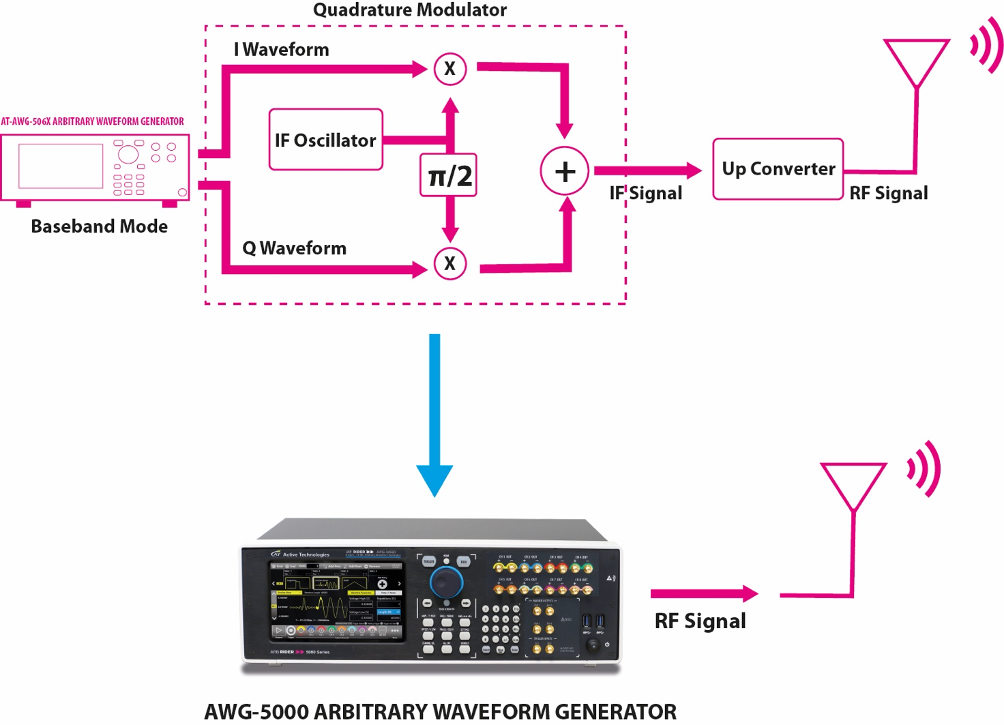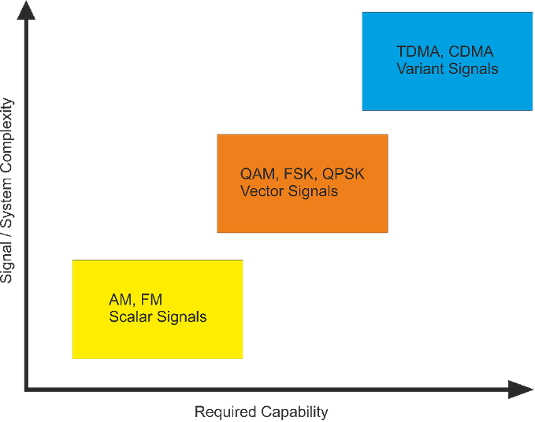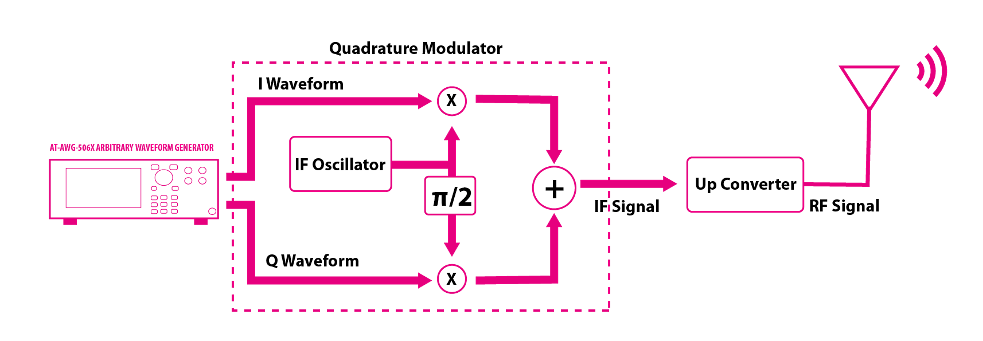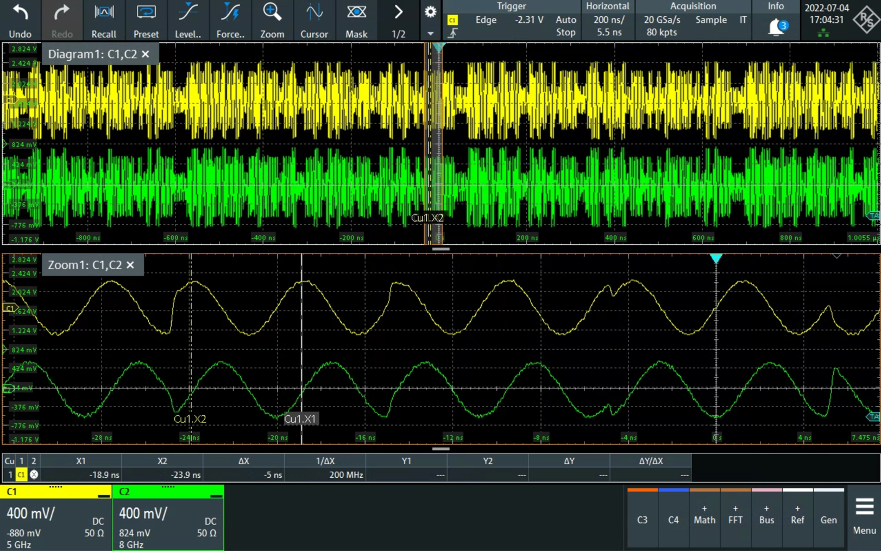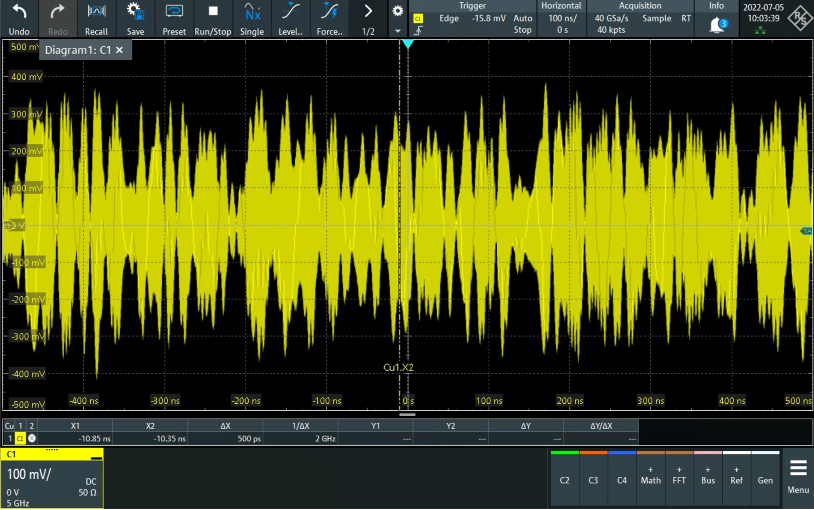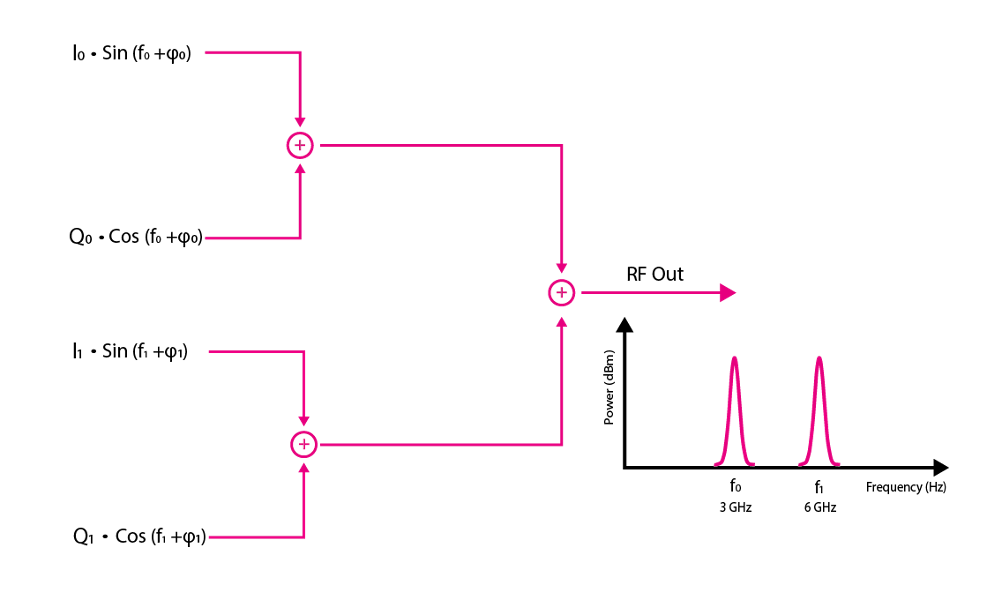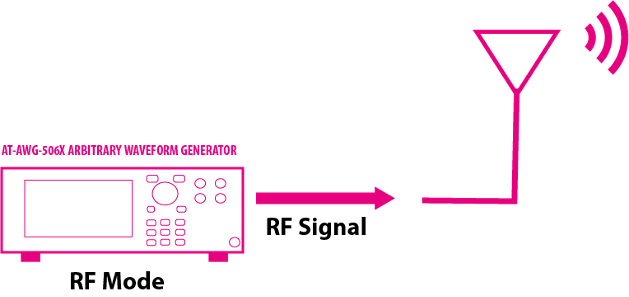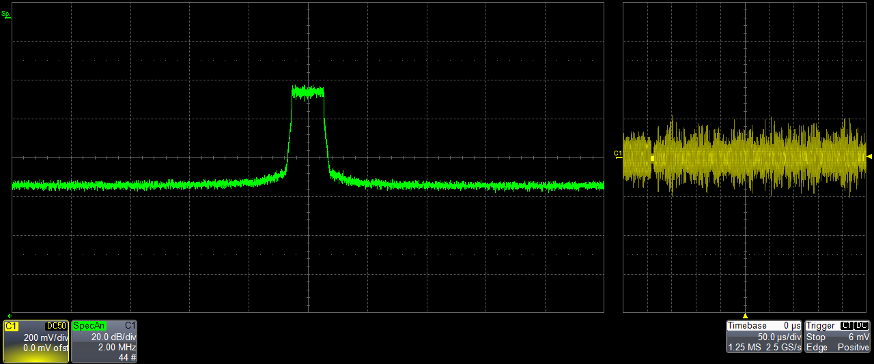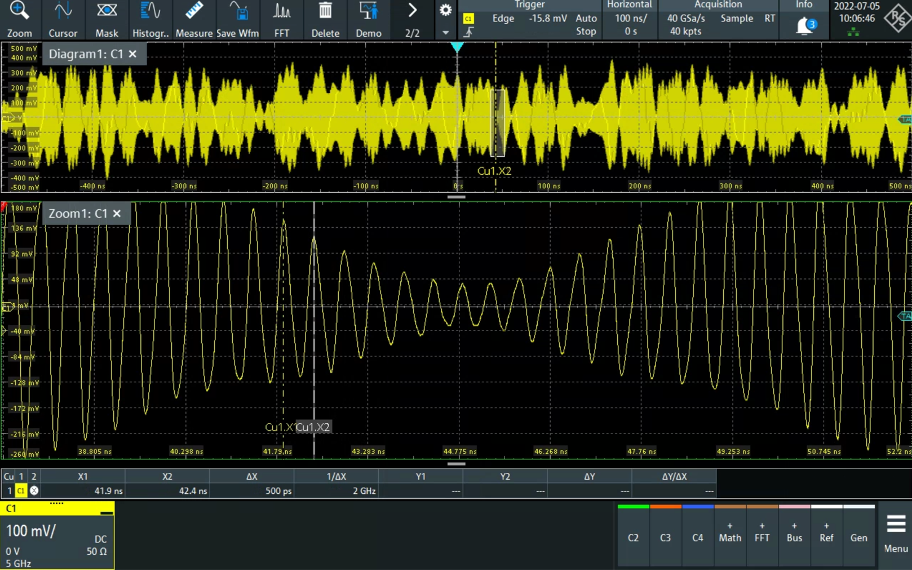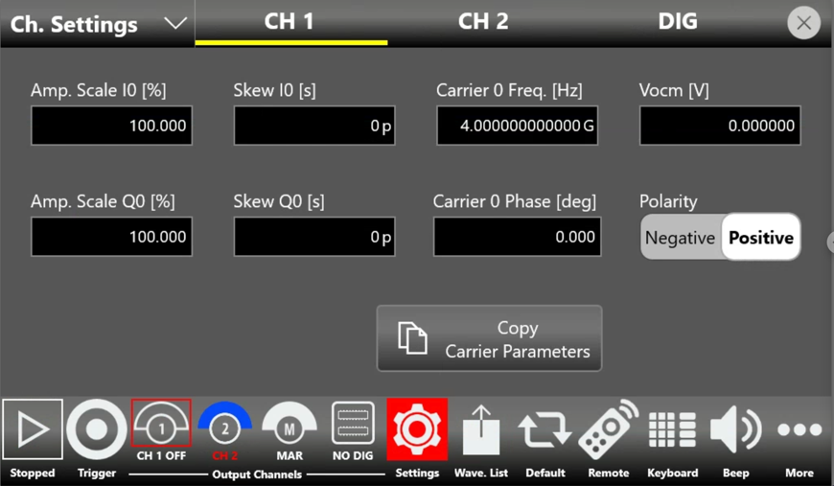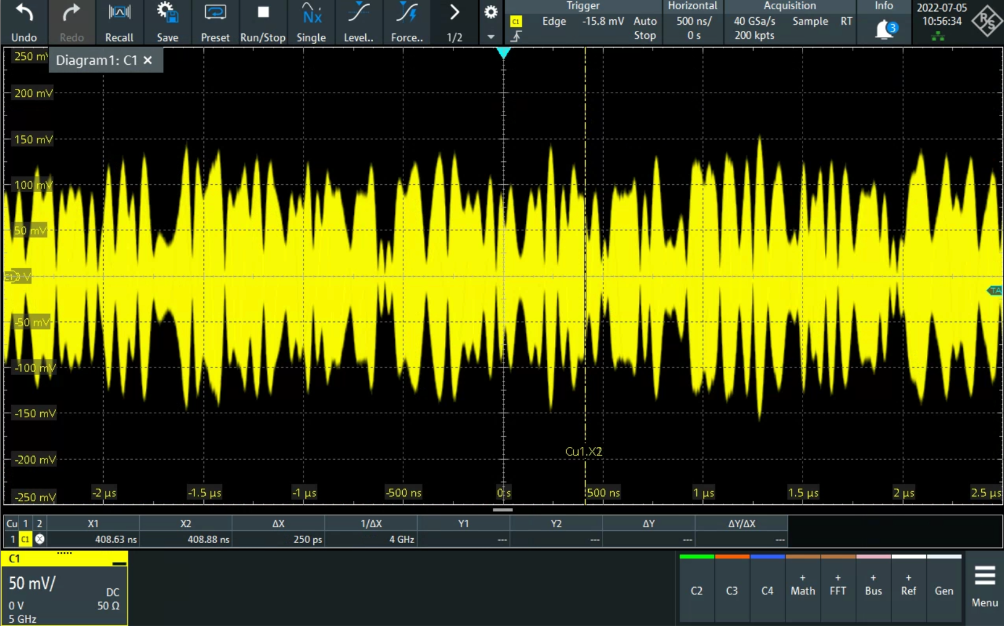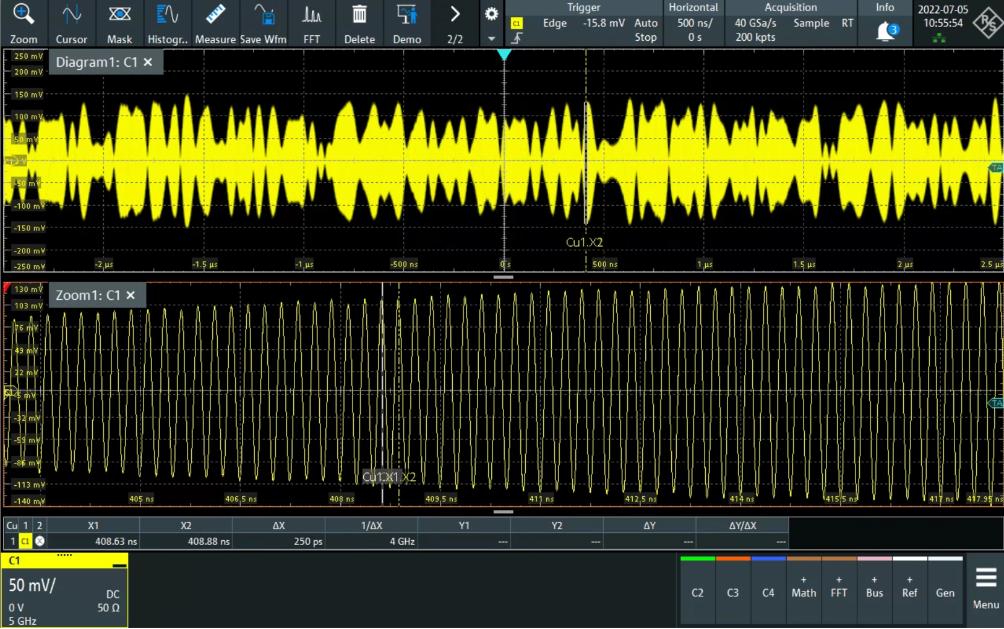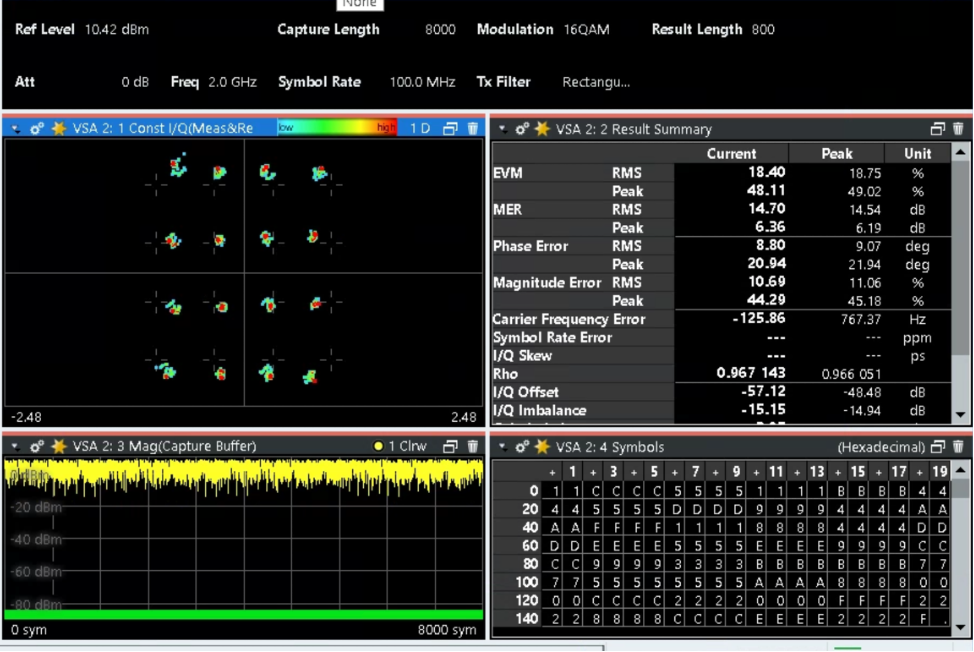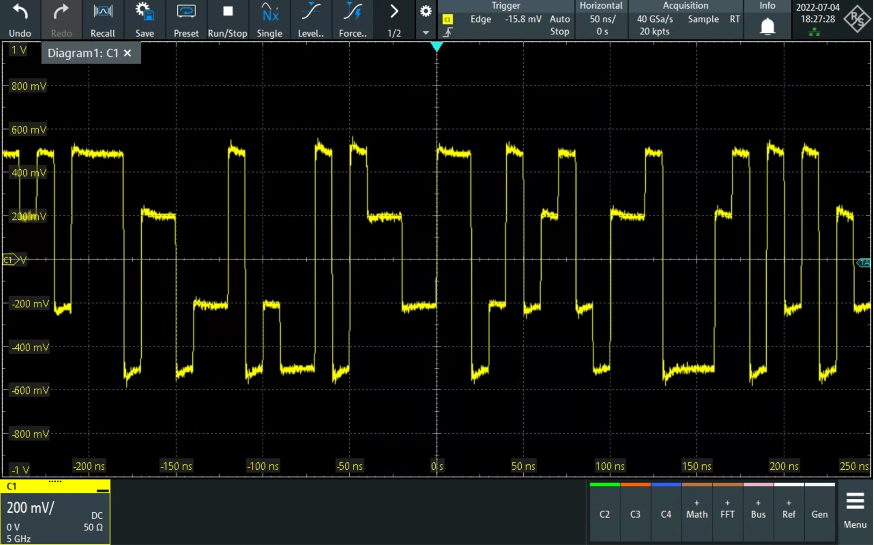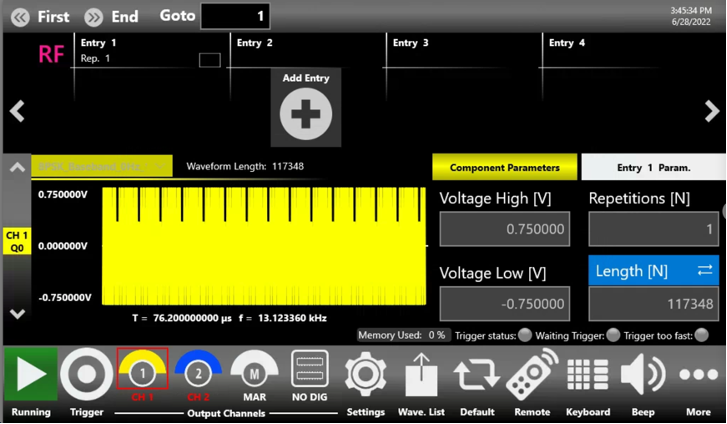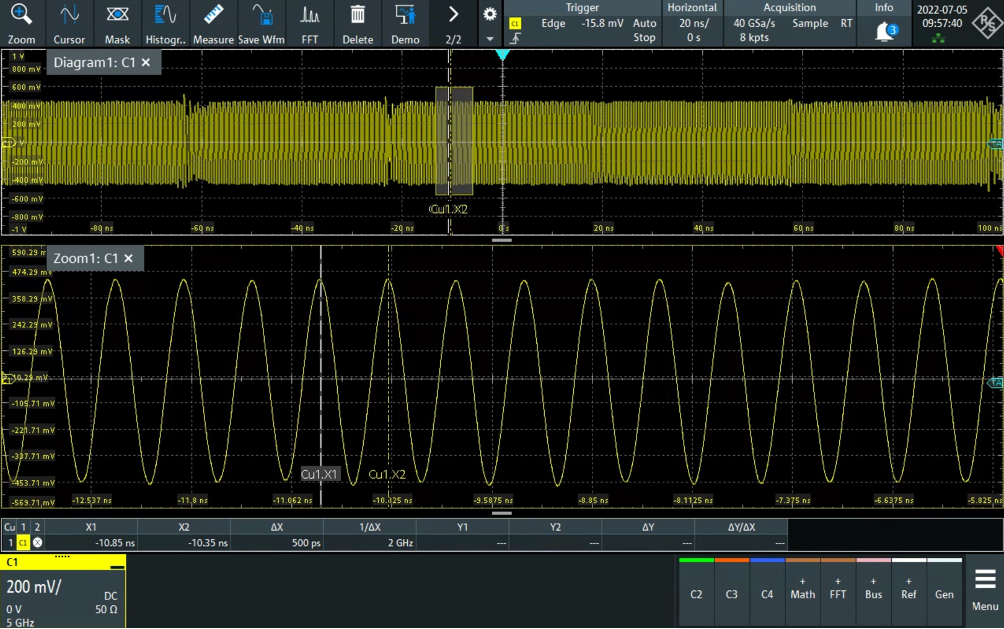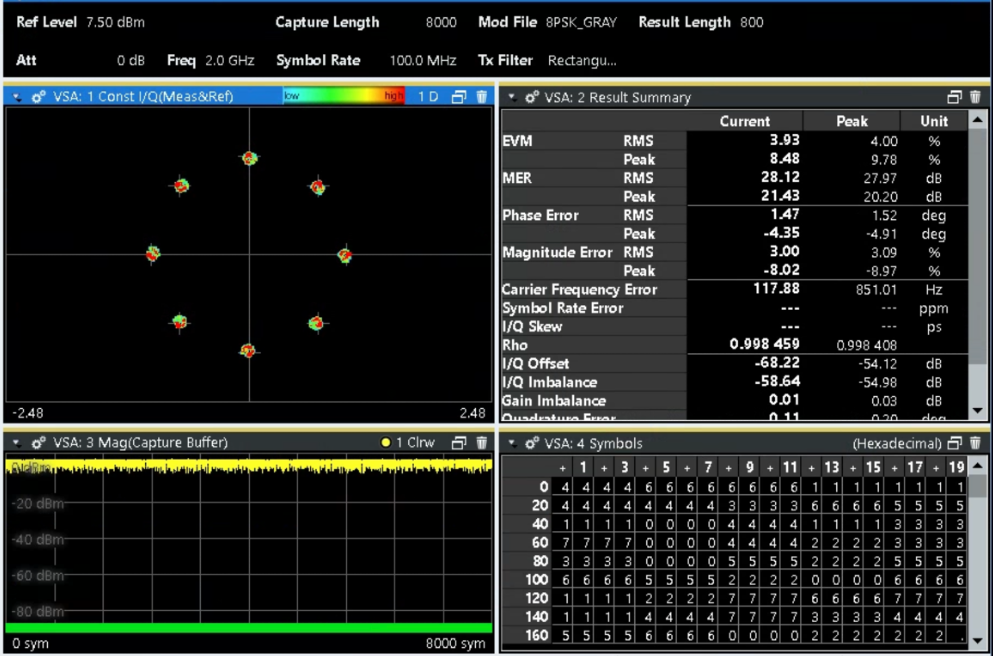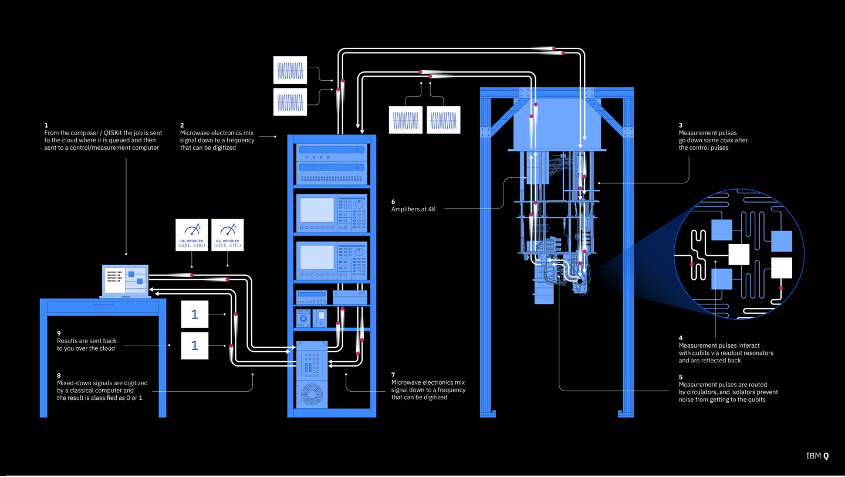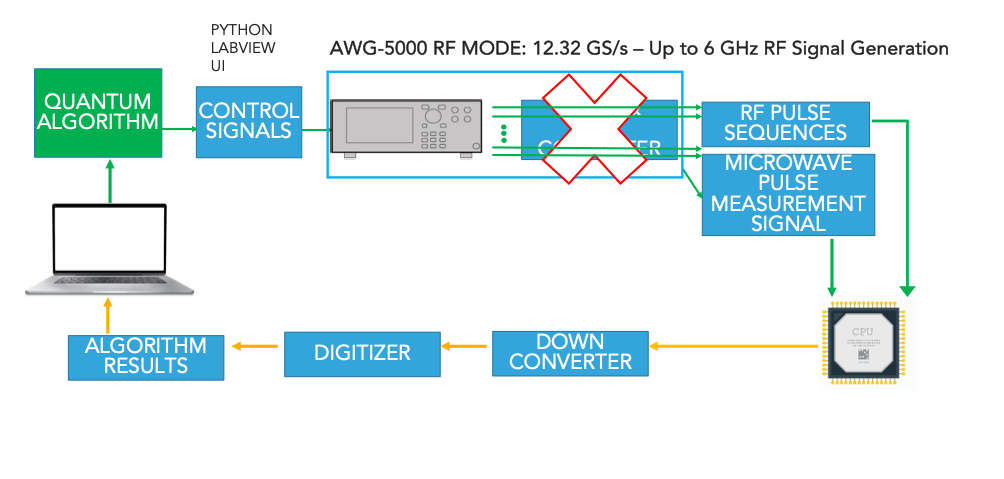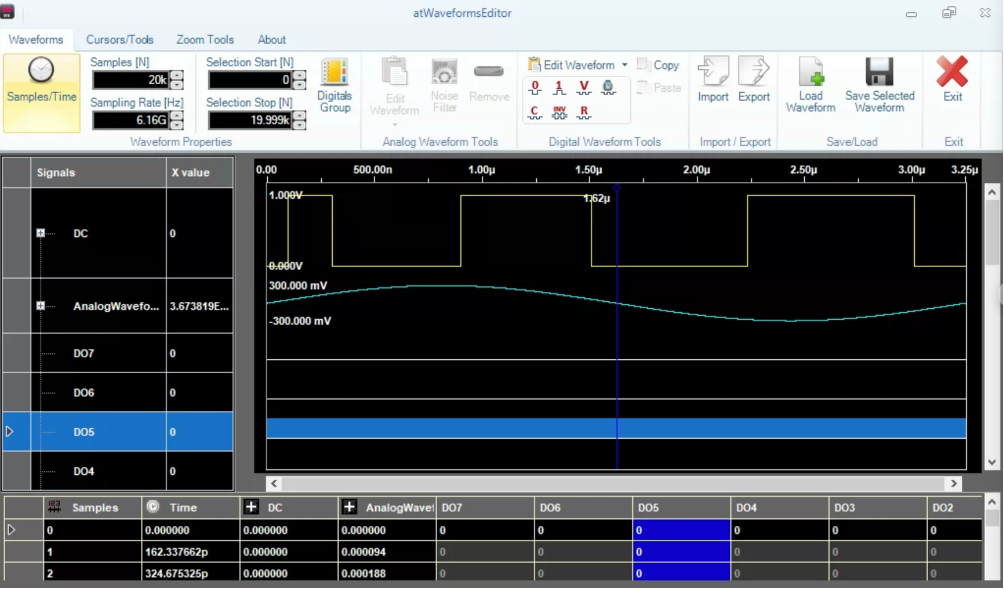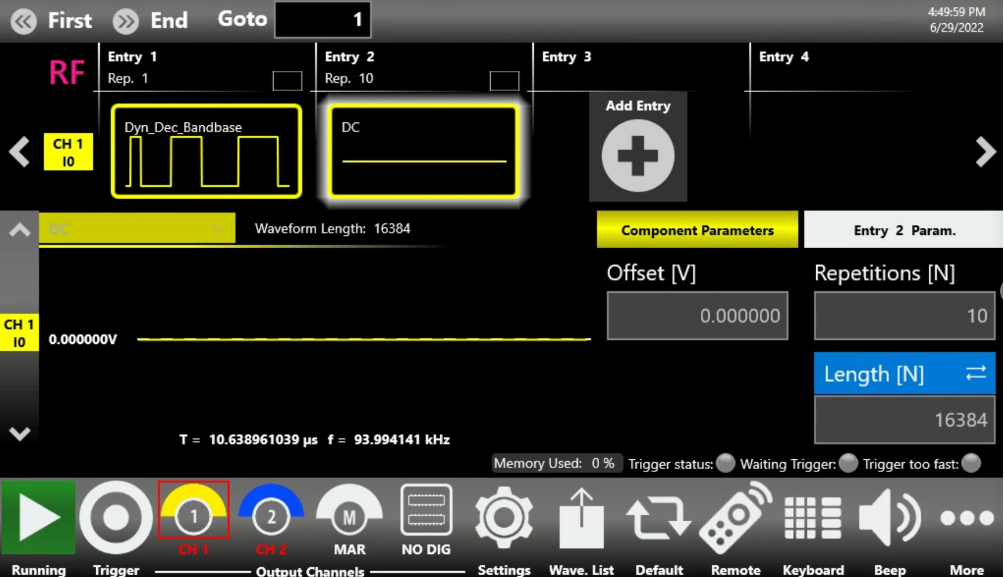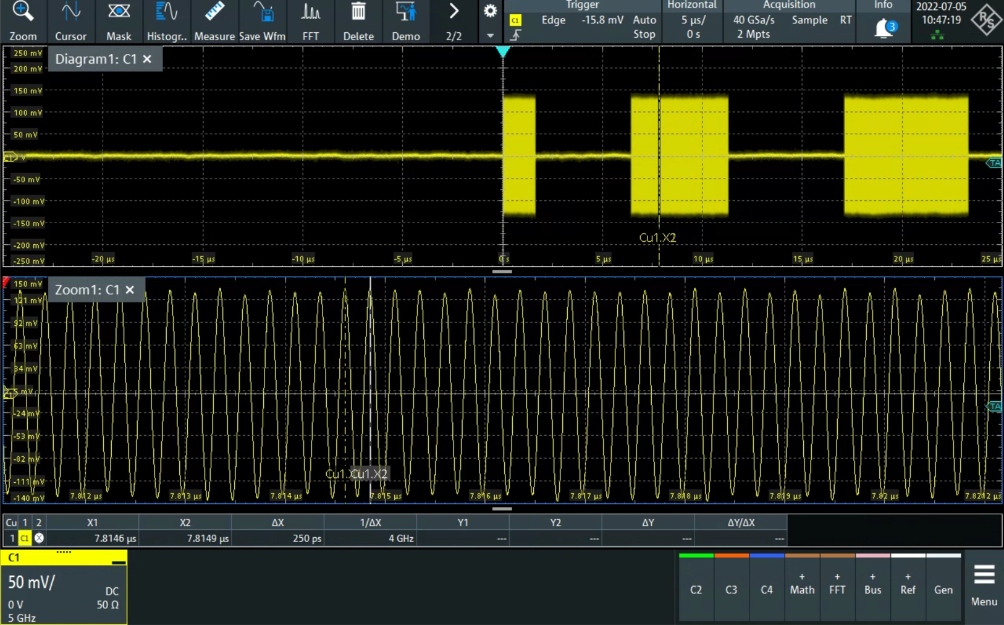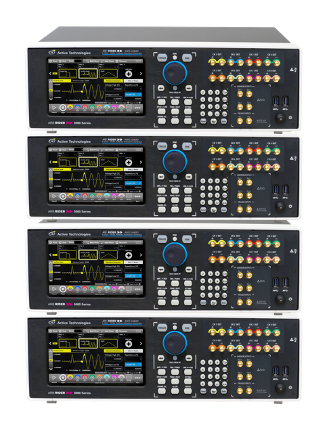RF AWG: 1.5GHz Instantaneous Bandwidth Vector Signal Generator
AWG-5000 Series White Paper – RF Mode
RF AWG vs Vector Signal Generator
In modern digital communication, usually baseband signals consist of two digital signals called I (in-phase) and Q (quadrature) that are combined by a modulator; this is the reason why to reproduce this kind of signals it is necessary an AWG with two synchronized channels.
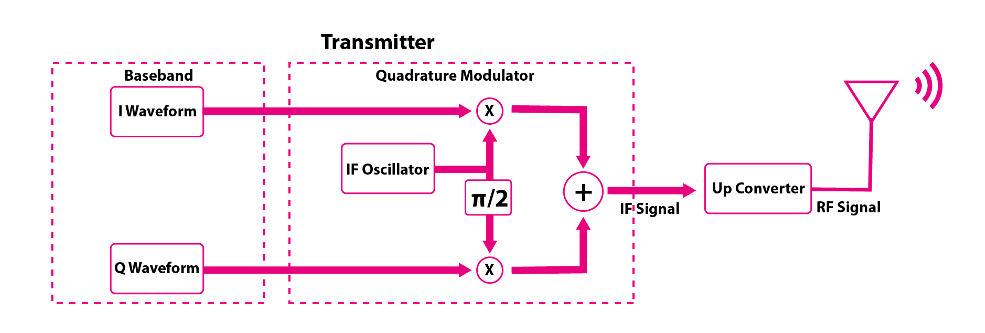
Although modern communications are based on digital technology, the output signals are analog ones and they have the typical problems of that domain: noise of the device that reduces the maximum SNR, non-linearity, quadrature errors, imbalances between I and Q channel that cause a distortion of the symbol constellations and a reduction of the theoretical performance.

The modern state of art Arbitrary Waveform and Function Generators are giving to engineers a powerful instrument to produce all type of signals and modulations (QAM, QPSK, DQPSK, PAM) to test different stages of a transmission or reception chain, such as modulator, demodulator, mixer, filter, amplifier, Low Noise Amplifier (LNA), etc.
This paper describes how an integrates solution like Arb-Rider AWG-5000. can implement a wide bandwidth Vector Signal Generator. The RF-Mode feature implements in hardware an internal mixer plus up-converter allowing you to cut the costs for external instrumentation and doubling the number of channels that can be used to generate RF Wireless signals or RF pulse sequences for Quantum Computing testing.
Instrumentation Used in this technical paper:
- Active Technologies Arb-Rider AWG-5000 Arbitrary Waveform Generator
- Rohde & Schwarz RTP 164 – 40 GS/s 16GHz – Digital Oscilloscope
- Rohde & Schwarz VSE Application for RTP oscilloscope
Baseband I/Q Generation
Using the Active Technologies Arb Rider AWG-5000 Series we can import two I,Q baseband signals previously created with Matlab or LabView and insert them into the Sequencer.
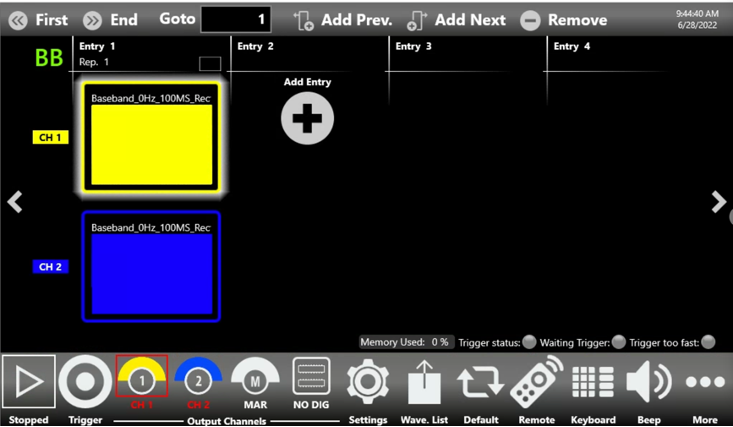
The two baseband waveforms inserted into the CH1 and CH2 are 16-QAM digital modulated signals with a symbol rate of 100 MHz.
The pattern applied is a PRBS-7 and the filter’s shape is rectangular.
In the screenshot below we can see the result of the Arb Rider AWG-5000 generation, the two channels are perfectly synchronized and the symbol rate is 100 MHz.
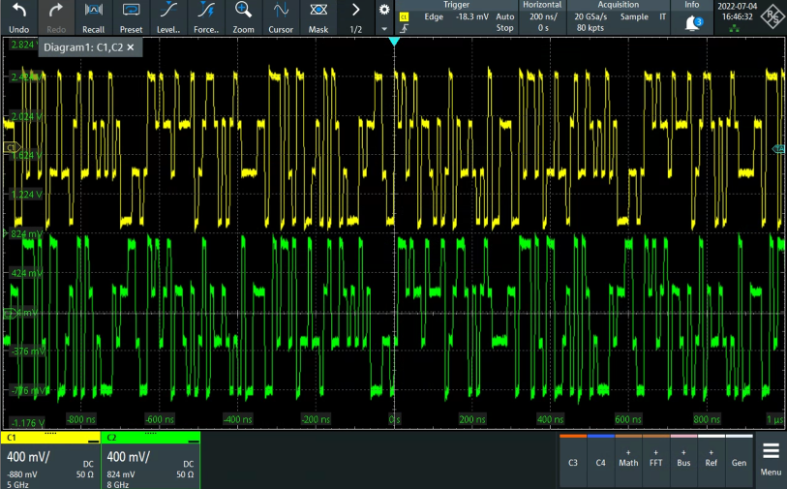
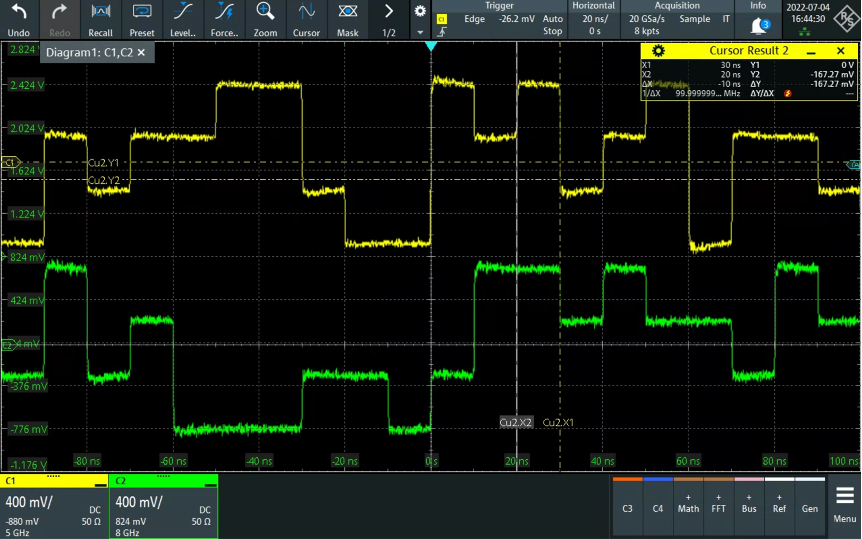
IF/RF Generation
The I-Q signals can be combined using an external modulator that could add unwanted distortion, moreover the modulator should be replaced in case of changing the modulation scheme under analysis.
The direct RF/IF synthesis by means of an AWG can overcome the problems described above.
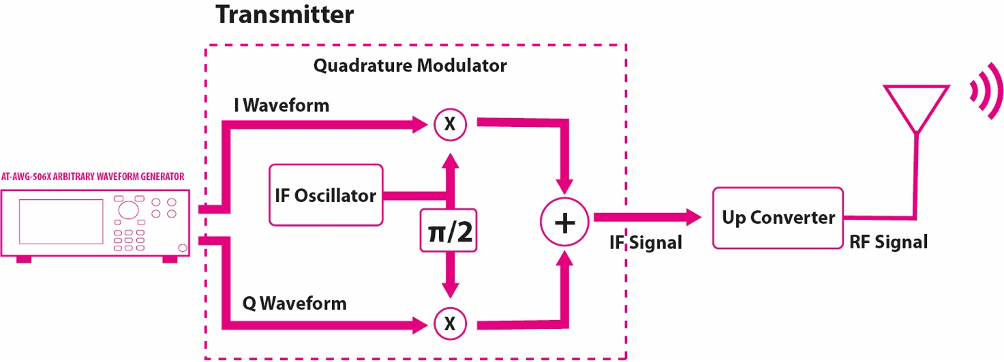
 Using a softwares like NI Labview®, Python, or Matlab / Simulink®, it is possible to create directly the RF/IF modulated signal by adding the imperfections and finally loading the result into the AWG memory.
Using a softwares like NI Labview®, Python, or Matlab / Simulink®, it is possible to create directly the RF/IF modulated signal by adding the imperfections and finally loading the result into the AWG memory.
The Arb Rider AWG-5000 Series in Baseband mode has a Real Time sampling rate of 6.16 GS/s and it can generate directly IF signals up to 2 GHz considering an oversample over 4 times to ensure a good spectrum quality signal.

In this test case, we have created an IF signal using Matlab with the following characteristics: 16QAM, 200 MHz Offset, Baseband 100 MS/s and we have inserted it into the Arb Rider AWG-5000 Sequencer.
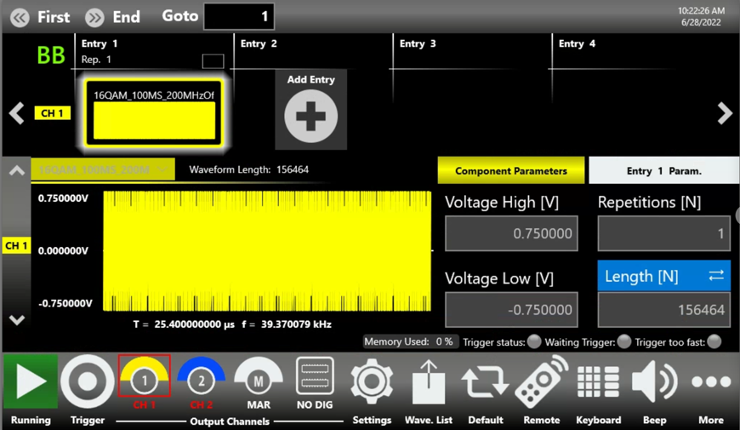
The oscilloscope’s screenshot reports the generation of an IF signal with a carrier frequency of 200 MHz. The signal can be directly sent to an external Up-Converter.
Moreover the Active Technologies AWG-5000 has an option called RF-Mode that has been developed for the direct generation of IF and RF signals.
In this example, we will use the RF-Mode to create an IF signal without needing to import it from Matlab or LabView software.
 Using the RF-Mode, we can easily load the I,Q baseband signals into the CH1-I0 and CH1-Q0 entry 1 of the sequencer.
Using the RF-Mode, we can easily load the I,Q baseband signals into the CH1-I0 and CH1-Q0 entry 1 of the sequencer.
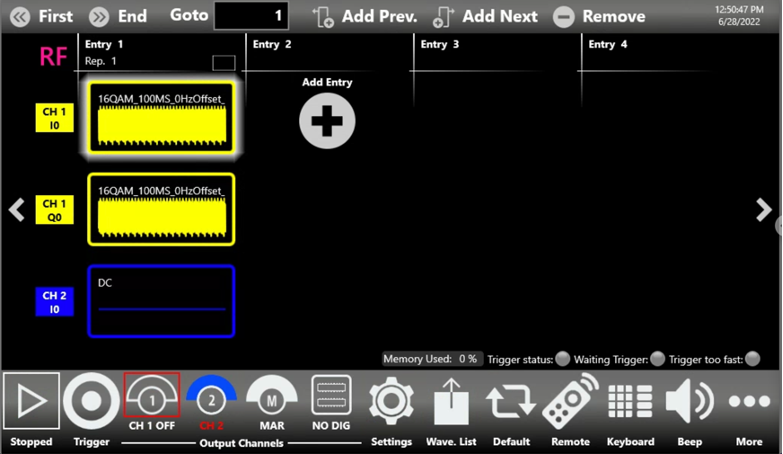
At this point, we can set the Carrier to the desired IF frequency, in this case 200 MHz.
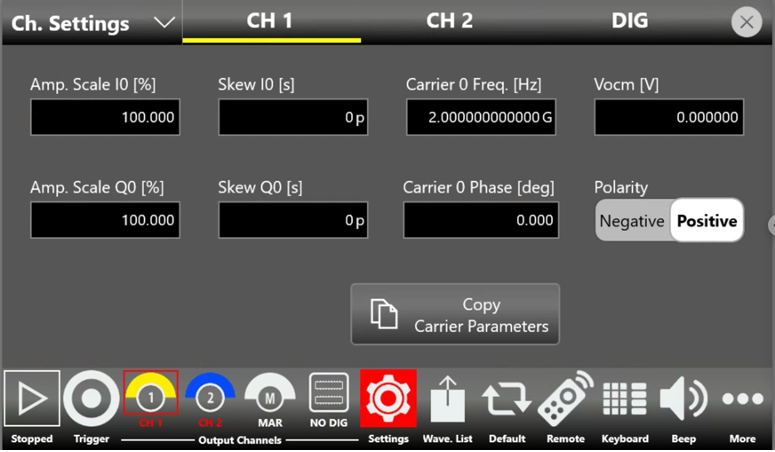
Two independent carrier Vector Signal Generator
The AWG-5000 Series Arbitrary Waveform Generator can work in Baseband mode with a Real Time sampling rate of 6.16 GS/s or in RF-Mode with an Interpolated sampling rate of 12.32 GS/s.
Using the RF-Mode, it is possible to generate RF wireless signals and modulated pulses up to 6 GHz. The internal modulator and up-converter allows you to create RF signals with one or two carries (Single and Double Carrier mode); using this mode it is possible to switch easily between two frequencies and add impairments in real-time like amplitude and skew between the different channels.
The example below shows you how to use the RF-Mode to generate RF signals with a carrier frequency of 2 GHz and 4 GHz without needing an external modulator and up-converter.The two I,Q baseband signals are loaded into the CH1-I0 and CH1-Q0 entry 1 of the sequencer and then the carrier frequency has been set to 2 GHz.
Now the carrier’s frequency has been changed to 4 GHz
The Rohde&Schwarz RTP164 – 40 GS/s, 16 GHz BW oscilloscope and the R&S VSE application allow us to demodulate the RF signal.
In the screenshot below we can see the 16-QAM constellation obtained with a rectangular shape filter.
It is possible to add impairments in real-time changing the skew between the channels or inserting a 30 degrees quadrature error.
Generate Signal using the M-PSK Method
Phase Shift Keying PSK is the digital modulation technique in which the phase of the carrier signal is changed by varying the sine and cosine inputs at a particular time.
PSK technique is widely used for wireless LANs, bio-metric, contactless operations, along with RFID and Bluetooth communications.
Using the Arb Rider AWG-5000 RF-Mode it is possible to create RF 8-PSK signals without needing an external quadrature modulator and an up-converter.
The Rohde&Schwarz RTP oscilloscope and the VSE option allows us to demodulate the RF signal and we can see the constellation of 8-PSK in the oscilloscope’s screenshot.
It is possible to apply easily impairments like I/Q quadrature error
Quantum Technologies
Quantum computers are very complex systems where each QuBit requires complex timed RF pulsed sequences.
The number of QuBits in a system is growing fast and typically two AWG channels are required for each QuBit.
The RF pulsed sequences are in the range of 4 to 10 GHz, so also an external mixer and up-converter are needed.
All these aspects reflect into scalability problems and nowadays it is fundamental to simplify the testing setup and saving the costs.
In Quantum computing experiments is useful to create Pulse Sequences for Decoupling a quantum state from the environment inducing decoherence.
The most common pulse sequences are called Carr Purcell Meiboom Gill and Uhrig decoupling sequences; they consist of π/2 pulse followed by N π, spaced as
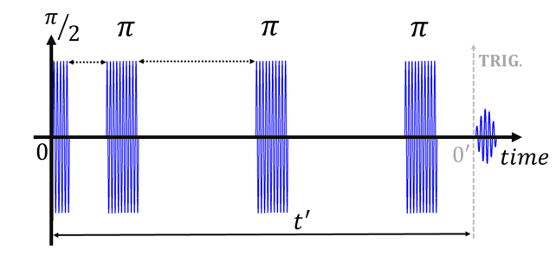 Using the Active Technologies Waveform Editor, it is possible to create the pulse sequence in baseband
Using the Active Technologies Waveform Editor, it is possible to create the pulse sequence in baseband
After having create the pulse waveform, the Arb Rider AWG-5000 allows you to modulate and up-convert up to 6 GHz your baseband signal using the RF-Mode.
We’ve created easily using this feature a Uhrig Decoupling Sequence RF modulated with a 2GHz carrier.
Multi-channel synchronization
One of the major tasks in Quantum sequences generation, it is the ability to generate high fidelity and precise signal sources.
The Arb Rider AWG-5000 allows you to generate up to 8 analog signals in a single device or up to 32 signal sources in a Multi-Instrument system fully synchronized.
Moreover it is possible to control the skew of a single analog output channel with a resolution <100 fs.
Conclusion
The newest technologies in Arbitrary Waveform Generators like the one applied in Active Technologies AWG-5000 allows you to integrate a quadrature modulator and an up-converter in a single instrument.
This solution permit you to double the number of channels available in complex systems like RF Wireless or Quantum computing where the channel density is becoming a key factor.
Moreover you can simplify your testing setup and reduce the costs of your T&M equipment.

